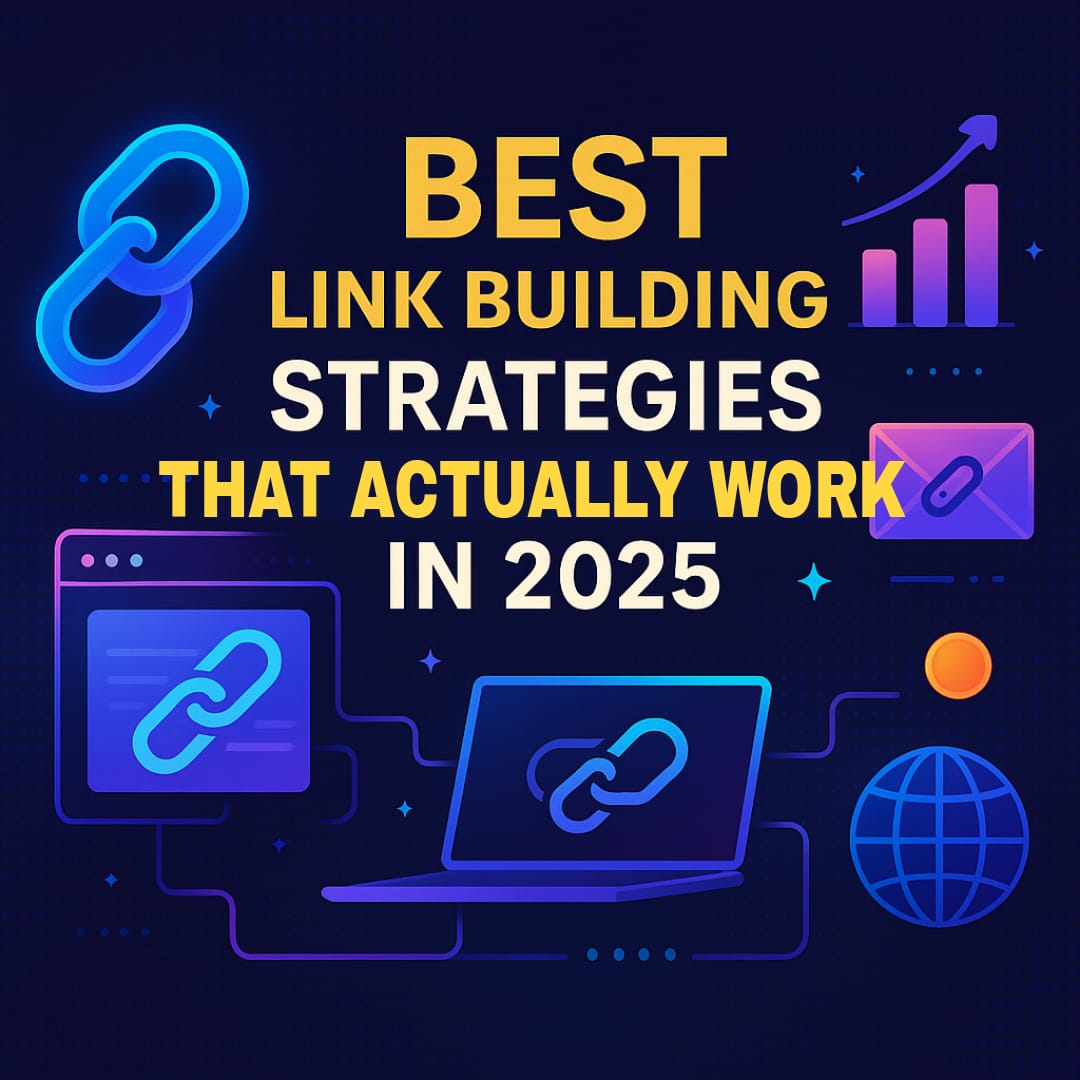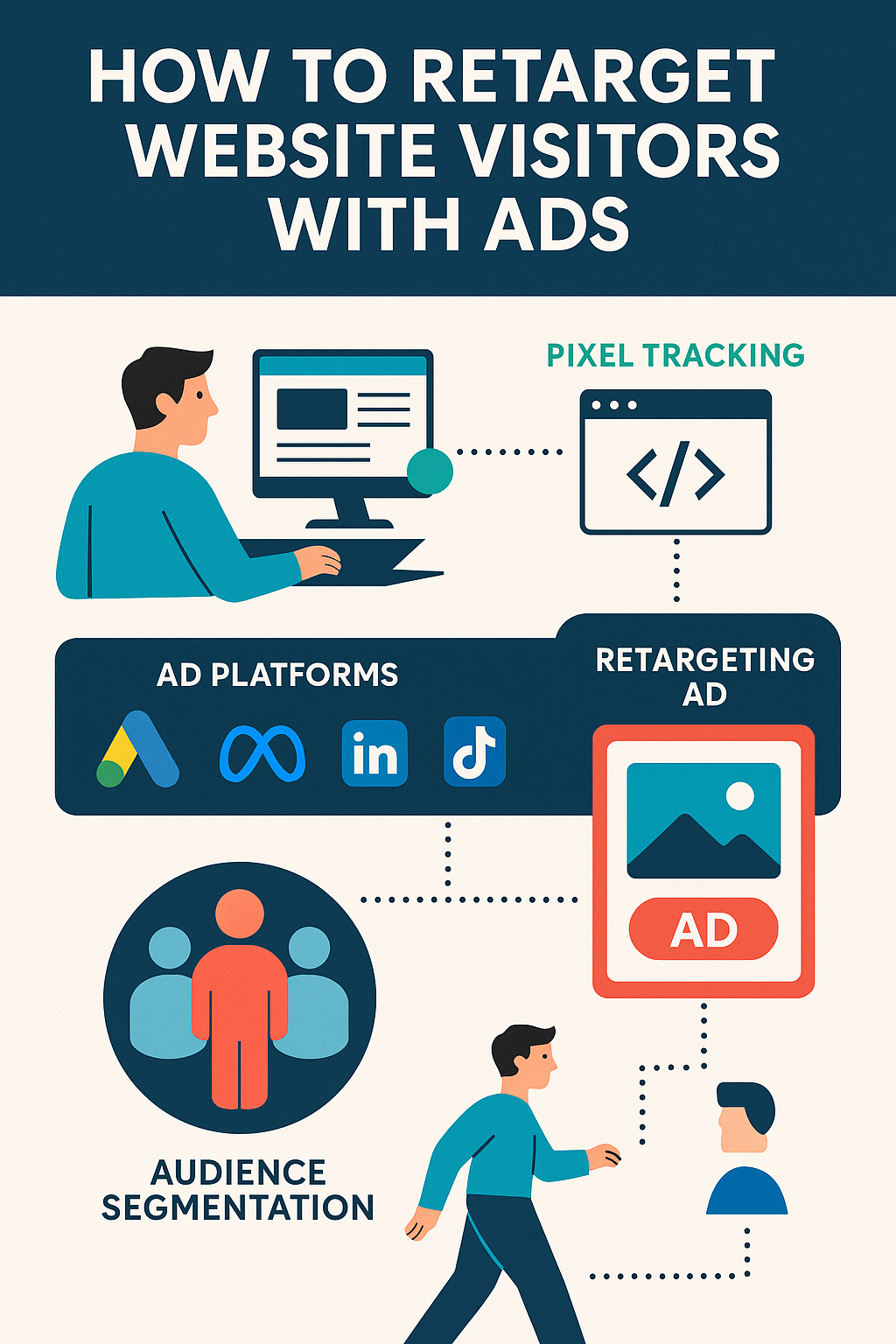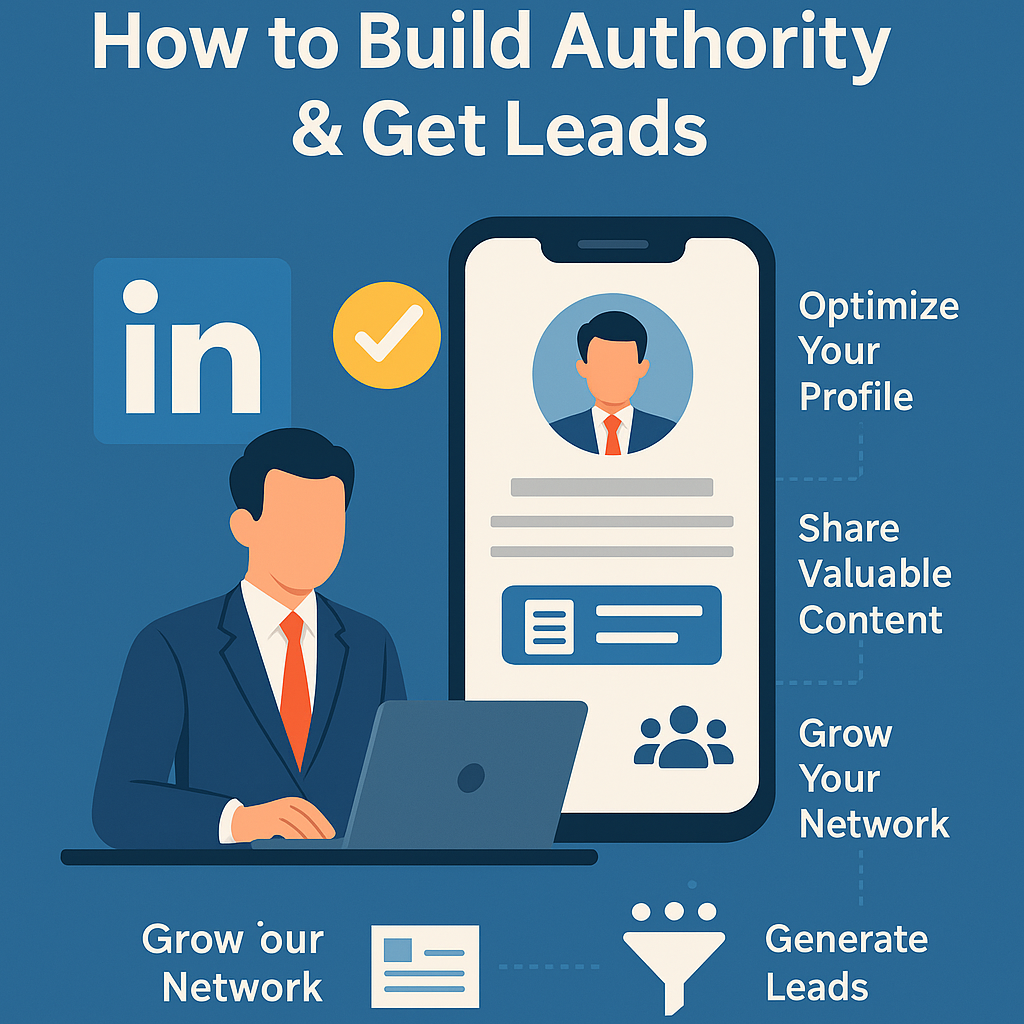Best Link Building Strategies That Actually Work in 2025
Table of Contents
Introduction: Why Link Building Still Matters in 2025
According to yoast, Link building refers to the marketing efforts to get links from other websites to your website. It’s seen as one of the most powerful tools to achieve higher rankings in search engines.
In 2025, Google’s algorithms are smarter than ever, courtesy of AI models that can recognize manipulation, spammy tactics, and unnatural backlink profiles. However, one thing that hasn’t changed is the fact that links are still one of the strongest ranking factors in SEO.
Backlinks can be thought of as digital votes of confidence. Each quality link pointing to your website indicates that your content is credible, authoritative, and worthy of being rated by Google above others. The catch is, not all links are created equal.
The SEO game is no longer about quantity, but more about relevance, authenticity, and relationships. Whether you have a blog, an eCommerce store, or a local business, link building with integrity will allow for long-term growth.
Let’s look at the best link building strategies that actually work in 2025, all based on the latest trends, Google updates, and expert opinions in SEO.
1. Focus on High-Quality Content That Earns Links Naturally
Every effective link building campaign is founded upon linkable content. In 2025, Google places a high priority on E-E-A-T (Experience, Expertise, Authoritativeness, Trustworthiness). This indicates your content needs to be not merely high-quality, but genuinely valuable.
What Works In 2025:
- Original Research: Carry out surveys or studies in your niche, and release the results. Other sites appreciate citing data.
- In-Depth Guides: Long, “ultimate” guides (like this article) below are still powerful for backlinks.
- Interactive Content: Tools, calculators, or quizzes that users find valuable receive natural links in most cases.
- Visual Content: Infographics, charts, and data visualizations earn backlinks faster than plain text.
Pro Tip: Feel free to use AI tools like ChatGPT or Jasper for brainstorming topics for your content, however, make sure your final piece has a human touch. Google favors authentic content over bot-generated or template-driven content.
2. Build Backlinks Through Digital PR and Brand Mentions
Digital PR has transitioned from a place of press releases to strategic storytelling. The concept is uncomplicated: induce journalists, influencers, and media sources to mention (and link to) your brand.
How To Do This:
- Use HARO (Help a Reporter Out): Provide journalists with inquiries and insight from one of your experts to use in their story. If they choose to use your answer, you receive a high authority backlink.
- Create Newsworthy Campaigns: Share your brand’s achievements, brand case studies, or a campaign that went viral on social media.
- Use data: Journalists love statistics. If you have some data or insight you feel is interesting, pitch it.
Pro Tip: Use tools like Muck Rack, BuzzSumo, and Prowly to find journalists looking for stories you are in that niche. Customizes your pitch. Robotic mass outreach is dead in 2025.
3. Guest Posting (But Done the Right Way)
When done correctly, guest blogging remains an effective practices for link building. Quality rather than quantity is critical here. In 2025 Google will launch a spam update that will directly impact guest posts on irrelevant or low authority websites.
Tips For Successful Guest Posting
- Write only for trusted websites in your niche.
- Make sure your content provides distinctive value and not just low-quality content.
- Avoid keyword stuffing the anchor text and strive for natural patterns.
- Don’t just cold pitch dozens of blogs; develop relationships with editors and website owners.
For example:
If you run a digital marketing agency, write for highly recognized blogs like Search Engine Journal, Moz, or HubSpot. These backlinks have real SEO authority.
4. Leverage Broken Link Building
The approach of broken link building is a greatly undervalued, yet potent technique. You can think of it as the SEO equivalent of being helpful and being rewarded for it.
Here’s the mechanics of how it works:
- You find broken links on a high authority website (for a website within your niche).
- You then have, or create similar high quality, content on your own website.
- You contact the website owner and ask them to please replace it with yours.
Tools you’ll need to do this:
- Ahrefs
- Screaming Frog
- Semrush
- Check My Links (Chrome Extension)
Tip: This strategy will likely be even more successful if you are conscientious about your outreach being personalized and friendly. Don’t sound like a spam bot – real help brings real links!
5. Skyscraper Technique 2.0
The Skyscraper Technique that Brian Dean brought to the mainstream some time ago has adapted for 2025 and beyond. The new, modern version doesn’t just improve what’s there. It enhances existing articles to include an interactive or multimedia element, and supports “link-worthiness.”
Here’s the New Formula:
- Find something in your niche performing well (lots of backlinks).
- Make something better, more helpful, better-designed, or add 2025 data.
- Add infographics, or other visuals with videos, or real-life case studies.
- Reach out to every person that linked to the original.
Bonus Tip: Consider AI-generated infographics or videos to enhance user experience — because users are linking to engaging media, more than a wall of text.
6. Build Links Through Community and Collaboration
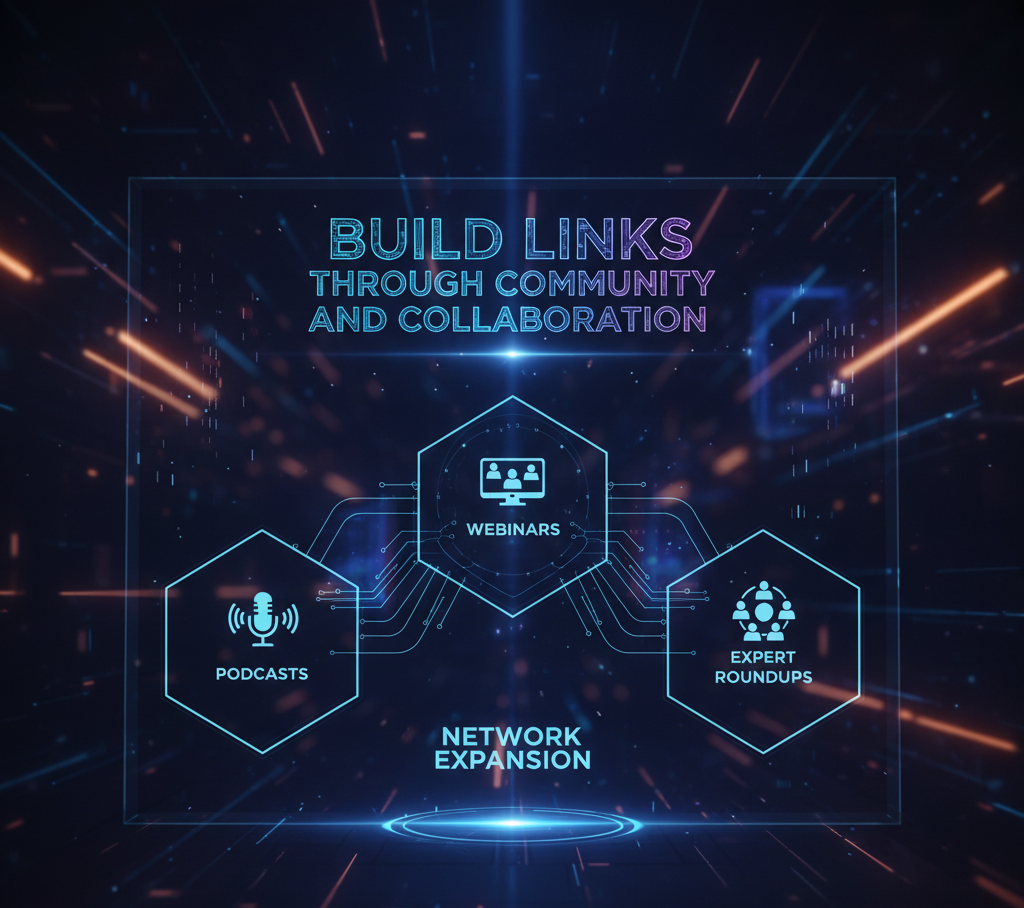
Networking has become the new SEO superpower. Partnering with others in your niche causes a snowball effect of backlinks, traffic, and authority.
Ways to Partner (Collaborate):
- Podcast: Guest on other people’s podcasts or start your own.
- Webinars: Collaborate with brands and provide thought leadership.
- Expert Roundup: Invite influencers to provide quotes to your article — they will likely (share and link to) it.
Pro Tip: Communities like LinkedIn groups, Reddit threads, and Slack channels are like goldmines for real connections that will lead to organic backlinks.
7. Optimize for Local and Niche Directories
If your organization is location-based or operated in a distinct industry, backlinks from niche directories can yield credit for SEO and visibility. However not all directories are created equally.
What Works in 2025:
- Only Reputable Directories: Google Business Profile, Yelp, Clutch, or a niche directory like Dribbble for designers.
- Stay Away From Spammy Listings: Low-quality directories can hurt your results.
- Add reviews & media: Authentic reviews, photos, and videos enhance the quality of your listing, resulting in higher rank and clicks.
Pro Tip: Local citations still improve your local SEO ranking (business name, address, and phone number mention) especially when consistent!
8. Repurpose and Promote Your Content Strategically
Developing awesome content is only part of the challenge; promotion is the other half of the challenge, and if you want to win the battle, you need promotion. Repurposing your amazing content creates additional longevity for your work and broader backlink opportunities.
Ideas for Repurposing:
- Transform a blog entry into an infographic, then share it on Pinterest or LinkedIn.
- Use research findings to create a video for YouTube and/or SlideShare.
- Publish micro-content or insights as a Twitter (X) thread.
- Post your content on sites where it will add value, like Medium, GrowthHackers, or IndieHackers (with backlinks to the original content).
More content conversions mean more opportunities for others to link back to your content.
9. Use AI and Automation Smartly (Not Lazily)
If used correctly, AI can supercharge your link building efforts. By 2025, countless marketers will have leveraged AI for checking competitors’ backlink profiles, scavenging for broken links, or creating outreach templates.
What’s working right now:
- AI tools such as Surfer SEO, Link Whisper, or Respona for personalized outreach.
- Predictive analytics to find backlinks before your competitors.
- AI also allows for quick content creation so you can execute link building programs quicker (but always have a human edit).
Pro Tip: Don’t turn everything to automation, humans still matter when it comes to link building because Google’s algorithm will always appeal for authenticity and backlinks with context.
10. Monitor, Analyze, and Disavow Bad Links
Building links is not a “set it and forget it” process. In 2025, keeping your backlink profile clean remains as crucial as building new ones.
Watch For:
- Toxic Backlinks: Any low-quality, spammy, or irrelevant domains.
- Anchor Text Diversity: Over-optimized anchor text can penalize you.
- Lost Links: Reclaiming lost links can help you regain rankings.
What Tools Can I Use To Track Backlinks?
- Google Search Console
- Ahrefs
- Moz Link Explorer
- Semrush
Pro Tip: Do a quarterly backlink audit and use Google’s Disavow Tool to disavow links that may jeopardize your SEO health.
Conclusion: Quality Links = Long-Term SEO Success
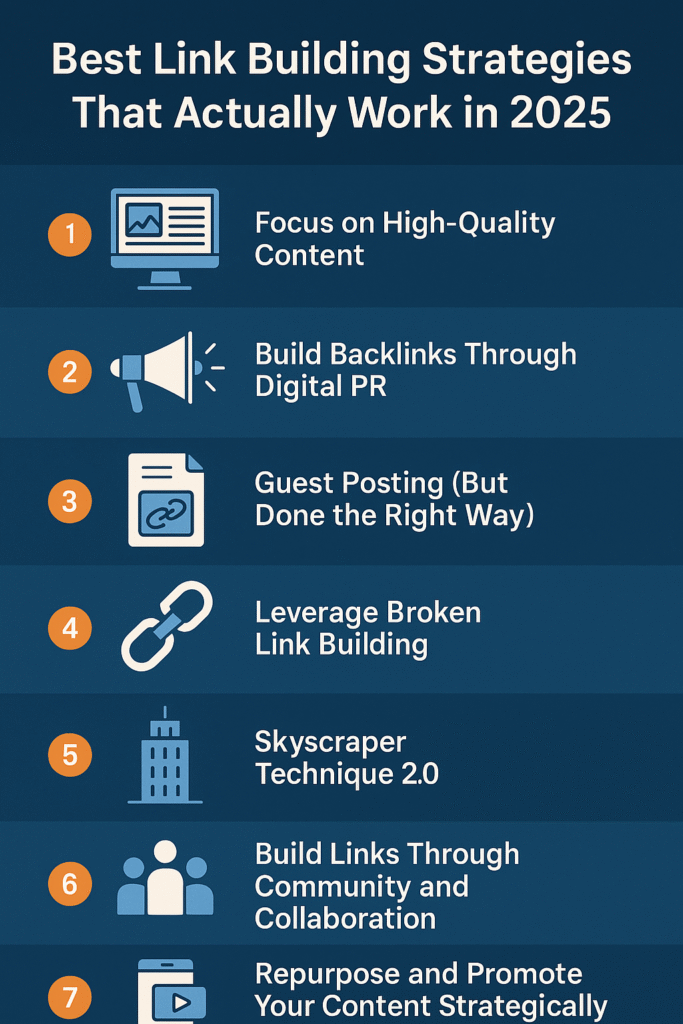
Link building in 2025 is no longer about taking shortcuts. It’s about relationship-building, relationship-building, relationship-building, earning trust, and genuine value.
Anecdotally, whether you’re a beginner or a seasoned marketer, the best strategies will always be about authenticity and consistency. If you create only high-quality, contextual backlinks, the rankings you want will develop, gradually and sustainably.
Link building is changing, however, this one relationship is unshakeable: great content + real relationships = growth you cannot stop.
For more such articles click here.
FAQs About Link Building in 2025
What is the best link building strategy in 2025?
The best strategy brings together tactics for digital PR, guest posting with a high caliber of article, and content that will naturally earn links due to the value of the content in the context of the site.
Are backlinks still important for SEO in 2025?
Absolutely. Even as AI-based ranking systems emerge and take hold, backlinks remain a key signal of trust and authority in Google’s eyes.
How many backlinks do I need to rank?
There is no magic number. Overall quality/relevance should be prioritized over quantity.
Are paid backlinks worth it?
Usually not. Google has become more and more aggressive against the purchase of unnatural links that do not comply with their guidelines. Using white-hat methods for link building would be a better investment of time and resources.
Can I use AI to help with link building?
Yes, AI tools can help with speeding up some elements, such as research and outreach, but AI is not able to replace the human touch for personalization of outreach messages.
How long does link building take to see results?
You should see visible improvements in terms of SEO within about 2-4 months to start seeing any measurable improvements. It will depend on how competitive your space is and the quality of content being used.
What do we mean by a toxic backlink?
A toxic backlink is essentially a low-quality, spammy, or irrelevant link that can work against your SEO rather than for it.
Is guest blogging or guest posting still effective?
Yes, if you are guest blogging on high-quality niche sites that have original, valuable content.
What are some of the most common link building mistakes?
Buying links, spamming outreach emails, and overusing exact-match anchor text.
How do I find my backlinks?
You can monitor, audit, and analyze your backlinks through Google Search Console, Ahrefs, Semrush, or all three.
